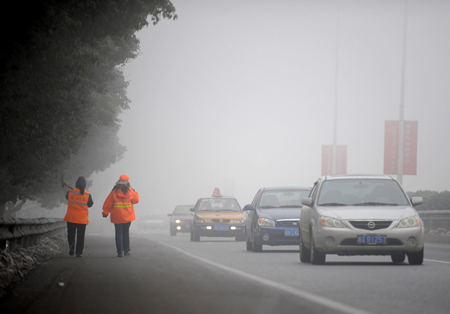Heavy fog hits frozen south China, adding to transport woes
Updated: 2008-02-04 11:08
BEIJING - Parts of south China affected by the worst winter weather in 50 years were shrouded in heavy fog on Monday morning, adding to traffic woes caused by snow and frost over the last three weeks.
Visibility was less than 100 meters in parts of Chongqing Municipality and the provinces of Anhui, Jiangsu, Zhejiang, Hubei, Jiangxi, Hunan and Guizhou, the China Meteorological Administration (CMA) said.
Meanwhile, a new wave of snow, rain and sleet is likely to hit parts of central and south China on Monday and Tuesday, including Chongqing and the provinces of Hubei, Henan, Yunnan and Guizhou, the CMA warned.
The heavy fog may worsen the traffic chaos on expressways and affect flights in central, eastern and southern regions.
Hundreds of thousands of people, mostly migrant workers, who are returning home for family gatherings during the Spring Festival holiday that starts on Wednesday, are still stranded on icy expressways and at train stations.
At 8:00 p.m. on Sunday, 92,000 passengers were stranded at the railway station in the southern city of Guangzhou and another 15,000 at the railway station in Shanghai, according to the emergency command center under the State Council, China's cabinet.
Meanwhile, about 17,000 vehicles were stuck in nine sections of expressways in different parts of China, the center said in a statement.
The snow has been falling since mid-January, leading to deaths, structural collapses, blackouts, accidents, transport problems and livestock and crop destruction.
The snow havoc has hit 19 provinces, municipalities and autonomous regions, toppled 223,000 homes and damaged another 862,000, according to the Ministry of Civil Affairs.
The ministry said almost 7.8 million people had been affected and at least 60 people had been killed.
The People's Liberation Army (PLA) of China has deployed 306,000 soldiers to remove ice on expressways and to help in other ways.
About 1.07 million militia and army reservists were also participating in the relief efforts.
In addition, more than 12,000 medical teams with 65,500 staff have been dispatched to snow-stricken areas, according to the Ministry of Health.
Zheng Guoguang, CMA head, blamed the La Nina phenomenon and abnormal atmospheric circulation for the disastrous weather that has left millions facing a cold, dark Lunar New Year holiday.
La Nina is a large pool of unusually cold water in the equatorial Pacific that develops every few years and influences global weather. It is the climatic opposite of El Nino, a warming of the Pacific.
Zheng said the La Nina conditions developed in August throughout the tropical Pacific and strengthened at the fastest pace in 56 years. The average sea-surface temperature during the past six months was half a degree Celsius lower than normal years.
|
|
|
||
|
||
|
|
|
|
